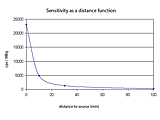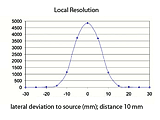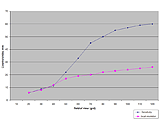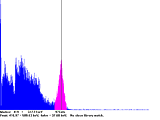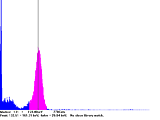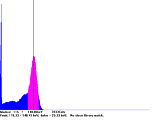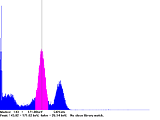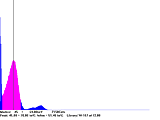Straight Gamma Probe: "HiSens"
1. Description
The straight probe "HiSens" is our standard probe for the detection of sentinel lymph nodes in the surgical treatment of cancer (sentinel technique, breast cancer, melanoma).
It outstandingly fulfills the requirements of a modern gamma probe. High sensitivity (> 20.000 counts/s/MBq) with an excellent side shielding (> 99.97% @ 140 keV), good spatial and angular resolution (17 mm, 40°) with a probe diameter of 15 mm. The straight probe allows the exact localization of the labelled lymph node already from some distance just by aiming along the axis of the probe.
The probe is optimized for the energy range around 140 keV (99mTc), and can be used for gamma-ray energies between 70 keV (201Tl) and 511 keV (PET).
When used intraoperatively the probe has to be protected by a sterile latex cover, as for example used in ultrasound diagnostics.
2. Technical Data
| Detector | CsI:Tl-scintillation crystal Ø 6 mm x 8 mm long, read out by a 20 mm2 pin-photodiode |
| Gamma-energy range | 60 keV … > 511 keV |
| Probe properties | length: 220 mm; length of cable: 3 m diameter hand piece: 20 mm diameter of tip: 15 mm weight: about 7 ounce (200 g) |
2.1 Collimation and Side-shielding
| Material | Tungsten, lateral thickness 3,15 mm (at all collimator sleeves with D = 15 mm), rear thickness 5 mm side shielding = 99,97 % @ 140 keV (99mTc) |
| Dihedral angle (FOV) | Standard 40° FWHM (20° or 60° on request) |
2.2 Background sensitivity
Zero effect < 0,3 cps = 18 c/min
2.3 Sensitivity and Resolution
The sensitivity of the probe depends on the used collimator. The basic sensitivity is determined by the standard collimator (40°). The sensitivity is shown in the figure - its depending on the distance between lymph-node and probe tip. The probe CXS-OP-SZBN has a high sensitivity > 20.000 counts/s/MBq.
The angular resolution with a standard collimator (40°) is determined in the near field (distance: 3 cm) and in the far field (distance: 10 cm).
The spatial resolution with a standard collimator (40°) is determined in the near field (distance: 1 cm). The probe has an excellent spatial resolution < 17 mm.
Spatial resolution, angular resolution and sensitivity depend strongly on the actual measurement conditions and from the selected collimator geometry. In the table spatial resolution and sensitivity of different collimators were determined in a water phantom.
| (distance tip-source: 30 mm) | collimator dihedral angle | |||
| 40° | 90° | 120° | ||
| local resolution in air | mm | 23 | 40 | 46 |
| local resolution in water | mm | 24 | 40 | 47 |
| sensitivity in air | Counts/MBq | 690 | 1360 | 1538 |
| sensitivity in water | Counts/MBq | 585 | 1120 | 1154 |
2.4 Energy spectra
The energy spectra of the probe CXS-OP-SZBN, recorded with nuclides used most in medicine:


